This post was triggered by a recent visit I made to a posh winery in the posh wine producing region of Barolo, in Piedmont (NW Italy). We were told that most of Barolo wines are exported to the United Sates and that this eventually led producers to tune their Barolo to the American taste, il gusto americano. This also made me wonder which share of European wine is eventually sold in the United states and, generally, which countries are the major global producers and consumers of wine. It also made me wonder whether the gusto americano syndrome also applies to French wines, with some surprising findings.
The text follows a somewhat meandering path, mixing personal anecdotes with data. I have tried to confine anecdotes to notes but I am realising that, though not being in any way an expert on wine production and trade, I have spent decades collecting and reading information on wine, focusing on techniques for wine production estimates, the origin of wine cultivation – especially in ancient China – and the thorny concept of wine quality. Wine is a complex mixture of water, anthocyanins, tannins, flavonols, ethanol, sugars etc. No-one seems to be able to list any blend of components that would make a “good wine”, but this has not prevented wine lovers and chemists to try… and to publish hundreds of articles on the subject in the scientific literature and beyond. Maybe I’ll write something on the subject one of these days.
My first encounter with Il gusto Americano
A couple of weeks ago, we visited a well known wine producing cooperative (just under 200 members) in the no-less well known wine producing area of Barolo in Piedmont, near Alba in north-western Italy. This exceptionally beautiful landscape was granted World Heritage status by Unesco in 2014.
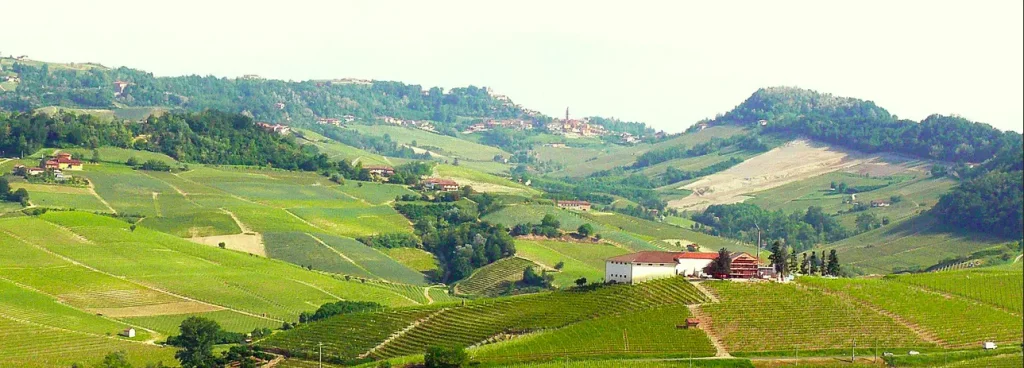
A fine lunch was served at the modern winery, designed about 20 years ago with visitors in mind: everything is visible, but nothing is accessible to the public. Call it “transparency” if you like.
Lunch was accompanied by a white wine made mostly from Sauvigon grapes and two red wines: a Barolo and a “Barbera d’ Asti”. We loved the white wine for its balance and subtlety, but did not really know what to think of the reds. Even if we readily admit that we are no wine experts, we tend to believe that a wine should not need any explanations to be deemed “good”.
After lunch and a board of cheeses (which some non Italians tend to prefer to tiramisu) we had the traditional tour with an obviously very knowledgeable guide who spoke excellent French, the result of his apprenticeship and his many visits to French winegrowers. Very surprisingly he was critical of several Barolo trends. He seemed to dislike the fact that his winery produces “almost forty labels” instead of focusing on what they are really good at. He also resented the fact that wine drinking has become a “recreational activity”: some people even drink red wine as aperitivo (so he said). His view is that wine belongs with food, and the right wine with the right food. Finally, he repeatedly mentioned that three quarters of their production is exported to the United States. As a result, he said the winery makes wine “al gusto americano” (“for the American taste”) which apparently not all lovers of more traditional Barolo like. Note, however, that the gusto americano is hardly the first revolution Barolo went through 1.
Piedmont is only the sixth region in Italy in terms of volume of wine produced, far behind Puglia and Veneto. Piedmont, however, produces almost exclusively quality wines. It has one of the largest shares of “Protected Designations of Origin” (PDO) among Italian wine producing regions. , some of which produce 4 to 5 times more than Piedmont. The share of PDO wines in Piedmont reaches 86.6 %, for a national average of 41.9 %. Sicily, on the other hand, produces mostly “table wines”. I suspect one of the aspects our guide at the winery did not like is the fact that his precious Barolo wines are being treated like table wines!
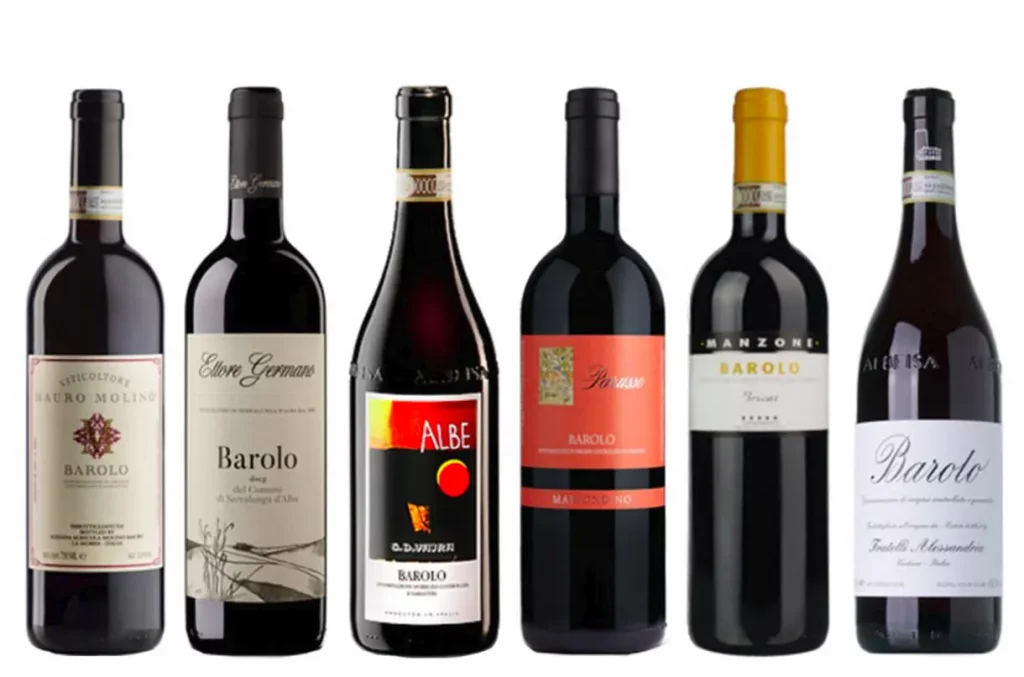
Among Italian regions, the bulk of exports comes from Veneto (36%) followed by Piedmont and Tuscany (both at 16%, according to 2019 data). The value of Piedmont wine exports reached 1 billion Euro in 2019. It is estimated that Piedmont wine exports absorb 60% of the regions’ s production, with shares from 40% (Brachetto d’Acqui) to 88% (Moscato d’ Asti). For Barolo, the share is 75%, which is the amount mentioned to us by our guide at the winery. Export shares for some other Piedmont wines are also available here. This does not include some excellent but more confidential brands such as Ruchè or Erbaluce wich, therefore are presumably immune from gusto americano.
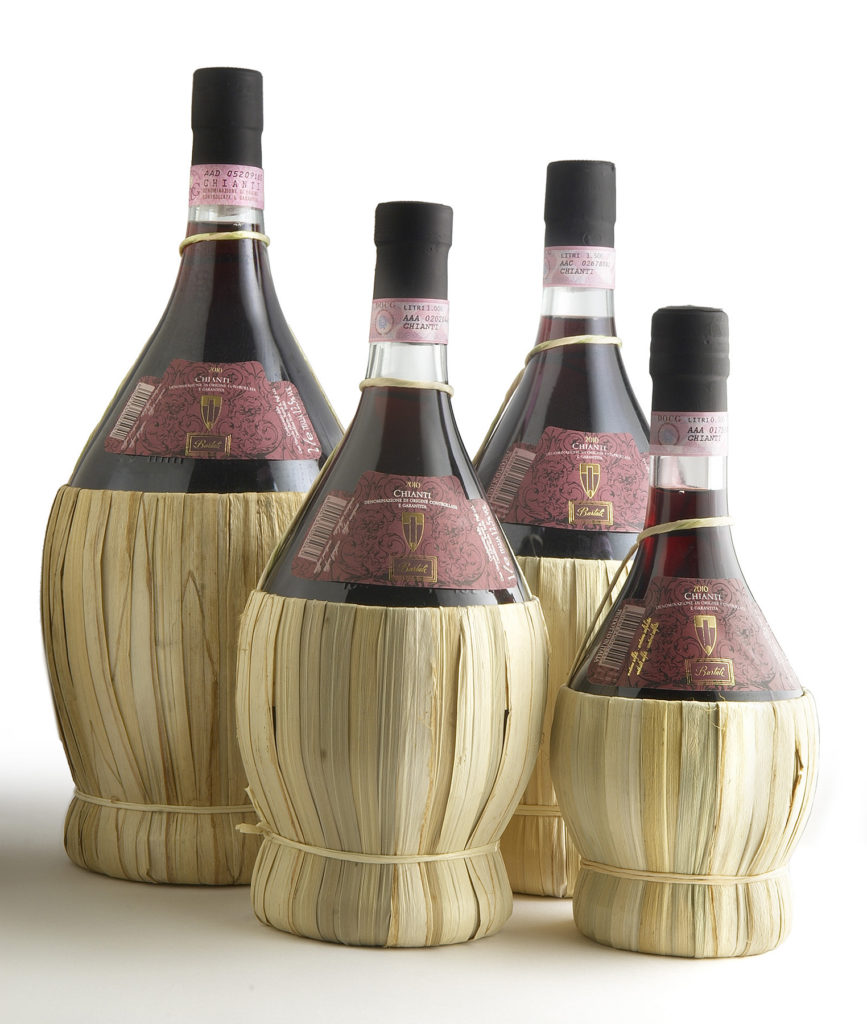
International wine production
I remember an old article by Philip Wagner in the June 1974 Scientific American2, where I read for the first time about Romanian and Georgian wine. The areas at the limit of the wine cultivation optimum produce some of the best wines, so Wagner said. Not being from a traditonnal wine drinking area or family, I was surprised to read about Romanian and Georgian wines, as we drank wine only at weddings, and that would always be French wine. We also knew Chianti because we had seen the typical flasks with their raffia wrapping, but all we knew, basically, is that wine is French or Italian.
According to FAOSTAT, the total average 2016-2019 wine production amounted to 271922690 hectolitres3, seven times less than malt beer. This is about equivalent to a cube with a side of 300 m. About 40% of the total production is traded internationally. In 2020 global wine production is listed as 260 million hectolitres, up 1% from 2019 but down 12% from 2018. According to the Statista website, the value of the global wine market is estimated at 420000 million US$ in 2022. FAOSTAT puts the value of the traded wine (2016-20 average) at 35000 million US$. Even if large amounts of wine are shipped in bulk, the difference between the global wine market (420 billion US$) and the traded wine (350 billion US$), i.e. 70 billion US$ shows the large difference in price between locally consumed wine and internationally traded bottles4.
It is difficult to visualize the amount of 420 billion US$. It is comparable with the GDP of countries such as the Philippines, Malaysia, Egypt and South-Africa, and exceeds the GDP of Denmark, Finland and Pakistan. It is about three times the GDP of Morocco or Slovakia and ten times that of Libya, Latvia or Uganda (based on 2021 World Bank data quoted in Wikipedia). 420 billion US$ is 57% of US military spendings and exceeds the Chinese defence budget by 40% (Wikipedia). On the other hand, 420 billion US$ is just 52 US$ for every person on earth in 2022.
In fact, the global wine “business” takes place between 40 or so countries5, with four dominant producers, exporters and consumers (PEC: France, Italy, Spain and Chile) and about 20 “pure” importers and consumers IC) who produce no or very little wine of their own… for now. In between, we have the “Anglo-saxons” (United States, South-Africa, Australia) and the Latin Americans (Argentina, Brazil). The first produce and import and consume wine (PIC) , while the second mostly drink their own production (PC). And then we have some outsiders such as China who rank near the top in all categories.
Needless to say, the categorization above between PEC, IC, PIC and PC is very rough. More detailed information is provided in the table below.
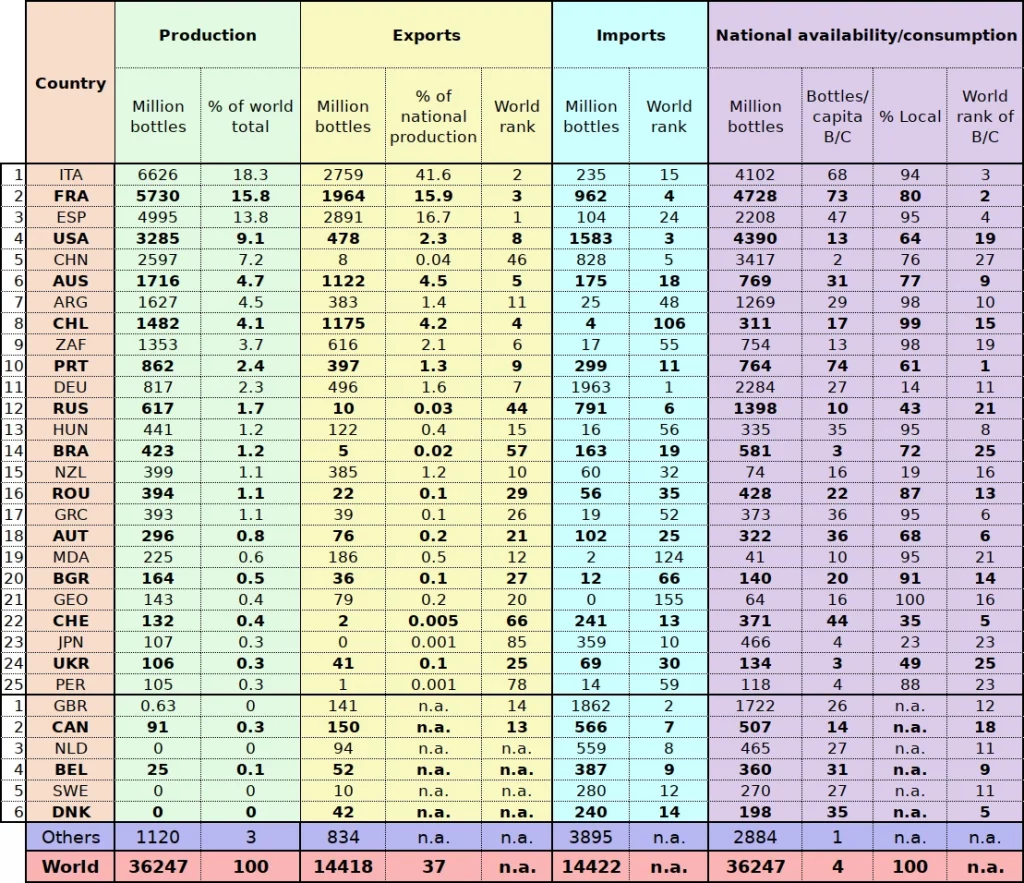
The first 25 rows list the main wine producers ranked in the reverse order of their production, with the last ones (below Greece) contributing less than 1% of world output and only five (Italy, France, Spain, USA and China) exceeding 5%. The bottom 6 countries (from Great Britain to Denmark) had to be included as they are all significant consumers but almost exclusively depend on imports for their wine supply8.
The top exporters are basically the same as the top producers, with the exception of the United Sates and China: both are high among producers (4th and 5th, respectively) but relatively low (United states, 8th ) or very low (China, 46th ) among exporters. Argentina is the 7th producer, but only the 11th exporter while Brazil ranks 14th and 57th, respectively, a situation not unlike that of Russia (12th and 44th) or Switzerland (22nd and 66th). Chile, on the other hand, ranks 8th among producers, but 4th as exporter. According to this source, the fastest growth of wine exports between 2018 and 2021 occurred in Ivory Coast (up 1,557% from 2020), several Caribbean countries, Zambia (up 218.8%), Belgium (up 215.7%), Taiwan (up 210%) and mainland China (up 192.4%). Increasing quantities of wine are shipped in bulk and bottled in the country of destination (80% in 2012 in Great Britain). Some of the largest wine companies even sell wine concentrates9!
Imports follow a very different pattern, with only France (4th ), China (5th) and the United States (3rd ) among the top importers. Germany and Great Britain are traditional major importers, as well as Russia, Canada, Belgium, the Netherlands and Scandinavians10
The last 4 columns attempt to answer the titles second question: Who drinks it?
Consumption is assumed be equivalent to availability, i.e. supply (production and imports) minus exports. Changes in stocks and wasted wine (Including stored wine gone bad) also play some part but were deemed negligible compared with the volume of production. We now find that a relatively minor producer, Portugal ranks first in consumption, followed by the main western Mediterranean producers in Europe: France, Italy and Spain. Portuguese, French and Italians all consume about seventy bottles a year. The following countries in the list consume about half that amount per capita (Australia, Austria, Belgium) while the United States is still lower at 13 bottles per person and per year. This can be seen as a plus for public health, but as a minus in terms of business opportunities.
Finally, the penultimate column shows that the French drink 20% of imported wine, while Italians stick to their national production (96% of their wine is locally produced). This results from the generally lower price of nationally produced wine, but also from a mixture of ignorance and nationalism11.
Who drinks most French and Italian wines?
With the exception of the Belgians, the Dutch and the Chinese, most wine importers seem to prefer Italian wines to French ones. This partially results from history and geographical proximity but also from local taste and, probably, the price of wines, with Italian wines tending to be less expensive or, and not necessarily the result of good logic, French wines tending to be more expensive, an affordable marketing trick based on the wines good reputation. Germans and Americans drink two bottles of Italian wine for every bottle of French wine.
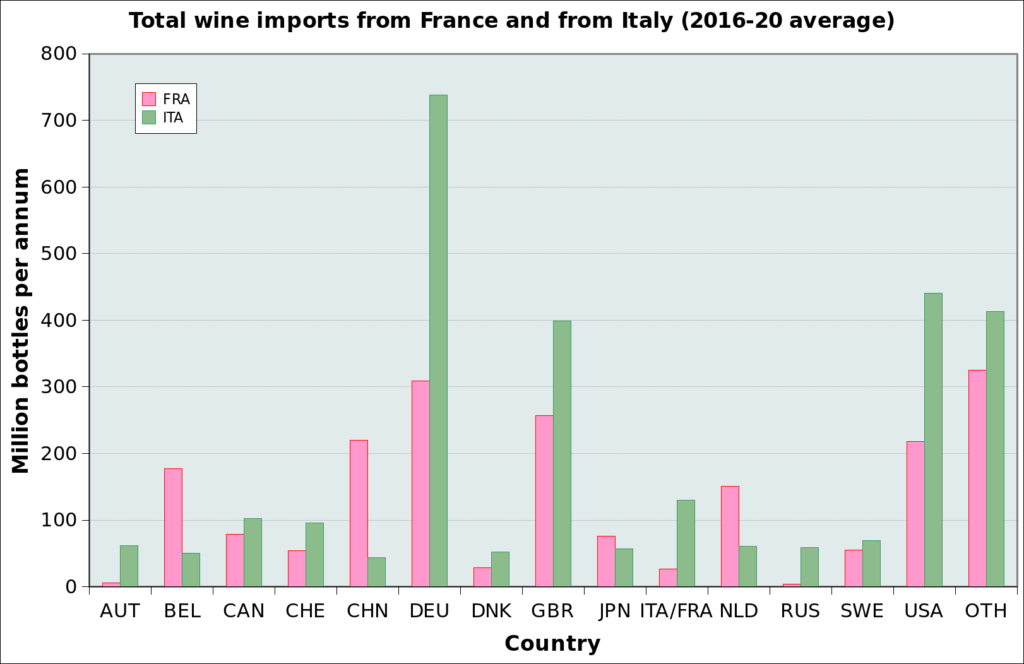
Another reason why Italian wines are popular is no doubt the excellent reputation of Italian cuisine in North America. This is fueled, among others, by the Italian diaspora but also by the fact that North American Italian cuisine is extremely inventive and serves many excellent and typical Italian dishes that were invented locally12.
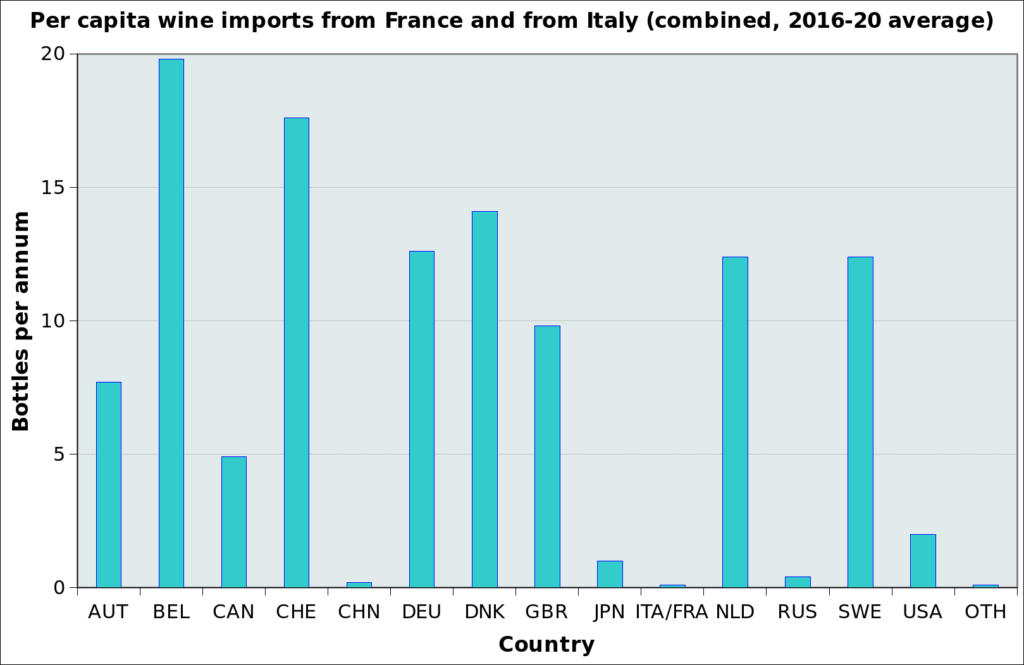
The Belgians and the Swiss are the major consumers of French and Italian wines in per capita terms. Of the 31 bottles a Belgian drink annually, 20 originate in Italy and France. The rest will be a mix of south American wine, some German (Riesling, for instance) and even less frequently Spanish, as well as a substantial amount of bulk wine, including blends of various origins sold, for instance, in cartons (Tetrapaks)13. The share is even larger (about half) in countries such as Austria, Canada or Great Britain. This does not mean that the wines are of bad quality: they have to compete with distinguished brands and, maybe, come closer to the gusto belga or gusto danese. Not only: many countries do not suffer from “wine image social pressure” and no-one will look down at you if you drink unknown labels14.
Back to Gusto americano, Goût français and Goût américain
I mentioned “wine image social pressure” above. Many countries do not have long wine drinking traditions, and this explains why most English language newspapers and magazines have their “wine critics” of which many are famous and respected journalists and authors of best-selling wine guides (not to forget the pocket guides). They know wines and advise the public, mostly using simple wording15, about the features and the prices of wines they recommend.
The wine critic can make or undo the reputation of a wine or a wine producer. They play a substantial role in the wine business and not by chance have several been decorated by the French government . They include Robert Parker in 1993 , Jancis Robinson in 2010 and James Suckling in 2021.
In fact, there is a undeniable globalisation of wine taste, with more and more countries producing French style wines. The fatal blow to the uniqueness of French wine came almost 50 years ago, in 1976, when a hand-picked French jury blindly ranked three Californian wines ahead of Mouton Rothschild, Montrose and Haut-Brion16. Since 1976, similar outcomes have been mentioned regularly for international comparisons of wines.
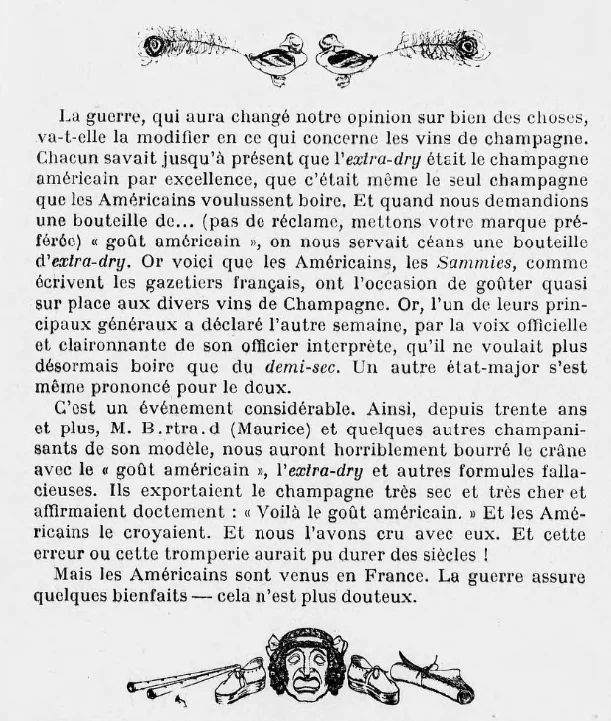
Interestingly, the earliest mention of Goût américain I found goes back to WWI. La Vie parisienne, a French weekly published for more that 100 years until 1970 mentioned in 1918 that US generals used to drink only extra-dry Champagne. But after coming to France they discovered other types. Le Pampre bleu website provides La Vie parisienne article: One of their top generals declared the other week, through the official and loud voice of his interpreter, that he only wanted to drink demi-sec. Another staff member even said he was in favor of sweet.
There is an undeniable convergence of gusto of wine as wine drinking expands and more countries learn how to produce quality wines, for instance China and Thailand or … Tanzania .
When I worked in Beijing I got to know and like several Chinese wines. Reading the labels, I discovered that some wineries were established more than 100 years ago, for instance Dragon Seal in 1910 or Changyu in 1892. They thus had ample time to learn how to make good wines to satisfy the huge local demand.
As to Tanzania, very few people know that the country is the second wine producer in Africa after South Africa. Here too, wine making goes back almost 100 years and was originally introduced by Italian missionaries. There are now succesful commercial wine producers which keep improving their products under difficult climatic conditions. Clearly, we are now dealing with a very different market, as the gusto tanzaniano favours sweet red wines.
- We mention, in the early 1800s, Paolo Francesco Staglieno and a rather interesting French noblewoman and, in the 1970s the so-called Barolo boys[↩]
- Wines, Grape Vines and Climate, Philip Wagner, June 1974 Scientific American, pages 106-115. Click this link for the map showing the northern and southern limits of quality wine cultivation in Europe. The legend to the map is given here.[↩]
- The accuracy of the figure is much less than suggested by the number of significant digit, as always with agricultural – and other – statistics.[↩]
- The cost of the bottles and advertising have to be accounted for too![↩]
- See the table linked to in the note[↩]
- Click this link for a list of the country codes[↩]
- In this post, “stocks” refers to wine stored by producers and merchants and specifically not to the stock exchange.[↩]
- The overall situation very much resembles that of soybean and some other crops, where the bulk of the output comes from just a handful of countries. I wonder to what extent this is not the rule. For soybean, for instance, we have three producers (USA, Brazil, Argentina) and one buyer (China), as I described a couple of years ago in the February 2014 Chinese CropWatch bulletin, pages 80-83 . For Opium, we have one very large producer and three smaller ones (Afghanistan, Myanmar, Mexico and Laos), with the first producing ten times more than the second. We have a similar picture again for hazelnuts, with the Nr.1 (Turkey) producing about ten times as much as Nr.2 (Italy). The situation is different for major staples such as wheat where 50% of world production comes from 5 countries, 80% from 15 and 90% from as many as 25 (2016-20 FAOSTAT data). A Pareto-type distribution seems to apply to the distribution of production data between countries high value commodities.[↩]
- Consult the following links for information about major global wine businesses, some of which have mind boggling sales: Link 1, Link 2[↩]
- With the exception of Finns (71st) and Norwegians (131st), who seem to prefer strong liquors, as amply demonstrated in Arto Paasilinna’s novels such as the year of the hare and others[↩]
- I have frequently met Italians who told me they had never had any French wine. Some restaurants, even relatively sophisticated ones in Piedmond, Tuscany or Umbria serve only regional wines. When I recently asked for a Bardolino at a restaurant somewhere south of Turin I got a horrified answer: Ma è un vino veneto! (But that’ s a wine from Veneto!).[↩]
- An internet search will find many Italian trattorie in Italy and other countries that advertise their cuisine as cucina casalinga or cucina casareccia, which means “homemade” or “like at home”. A French restaurant diner will prefer food that’s different from the food she eats at home![↩]
- Other alternatives include cans, PET bottles, bag in box and pouches; refer to this link to the website of Jancis Robinson, whom I shall mention again below[↩]
- Many years ago, my Canadian friend Ernest and I were drinking red wine while eating reblochon in Annecy. When his French brother-in-law saw the bottle we so enjoyed, he said “Quoi, vous buvez cette piquette?” (What, you drink that stuff?). Not being French, we went on with the reblochon and the piquette, and continued thoroughly enjoying it. I had met Ernest when the two of us were UN colleagues in Tanzania, and the first wine we drank together was Dodoma Rosé at the Taj Mahal in Dar es Salaam. We even had one bottle of Bihawana white which I was given directly by the local Italian priest in Dodoma region. The priest also gave me their long-tern rainfall records of which no-one knew it existed. I gave it to the Tanzania Meteorological Authority, but I wonder if they recorded it [↩]
- Listen to a French wine expert describing a wine and you’ll understand what I mean by simple[↩]
- This came to be known as the Paris Wine Tasting of 1976, or the Judgment of Paris. Refer to Wikipedia for details. Unlike most other Wikipedia entries, the French version has more detail than the English one[↩]
Petit problème de virgules et de points :
271,922,690 million hectolitres
is listed as 260 million hectolitres,
Merci,je corrige. La prochaine fois que tu passes par ici, par hasard ou à dessein, je t’emmène à Barolo! C’ est dur à vélo, mais ça vaut le coup d’ oeil.
Articolo tanto interessante quanto piacevole alla lettura. Ciò denota oltre la competenza del Ns scrittore René, anche una passione nella materia vinicola. È stato un privilegio trascorrere quella giornata in Vs. compagnia.
Un abbraccio.
Andrea
Grazie, Andrea, ma sei troppo generoso.
Super intéressant comme vision globale . Quant au gusto americano , je t’invite à approfondir le sujet dans un prochain blog car la mention que tu en fais mérite d’être mieux expliquée pour que l’on en comprenne les implications au-delà du simple goût. La majorité des vins ont des sucres résiduels ( de 1 à 2,5 gr /L ) à la fois pour répondre aux choix des consommateurs ( rien de rationnel là dedans mais fondamentalement il y a des préférences liées à la biologie de notre système gustatif ) et “arrondir” la saveur à la dégustation et/ou….cacher certains aspects d’une vinification en quête d’optimalité . Le vin que je fabrique n’a pas de sucre résiduel car levures et bactéries oeuvrent sans retenue pour la fermentation alcoolique et malolactique.
Merci, Michel
Un avis circonstancié d’un produteur de vin! Comme je le disais, je collectionne depuis longtemps de la documentation sur le concept très subjectif de “qualité” du vin. Voici ma conclusion du moment: ce qui définit la qualité d’ un vin, c’ est son prix. Et vice versa. Prix = qualité = prix. Même et surtout quand on inclut la publicité dans le coût de production. Logiquement, ça ne vaut pas pour les vins reçus en cadeau, comme ces bouteilles de blanc reçues du voisin d’ un ami commun de Vigne di Narni.
Bonjour,
Pas mal ton nouveau site ! Je le trouve un peu américain.
Le goût américain ici, en France-Belgique et en vin rouge, c’est celui de Parker, qui est certainement le critique le plus influent. Parker aime les vins puissants avec beaucoup d’épaules, et il n’hésite pas à proposer à un vigneron dont il remarque un vin, d’isoler une parcelle pour en soigner une cuvée distincte, plus à son goût. Je l’ai appris en lisant un vigneron qui avait refusé cette “parkérisation”.
L’américanisation du vin rejoint sans doute cet effort pour attirer de nouveaux et jeunes acheteurs: toujours en rouge, certains producteurs français veillent à ménager un petit goût sucré résiduel, pour faciliter l’intérêt de papilles biberonnant encore au sucre des “softs”. C’est presque imperceptible, mais cela rend le contact beaucoup plus facile, surtout au premier verre un peu distrait.
Des concurrents opposés à cette pratique parlent de “vins coca-cola”. Personnellement, je repère cet excès de sucre, et une fois repéré, on n’y échappe plus, c’est très irritant. Dans les limites de mon expérience, c’est surtout fréquent pour les vins du Languedoc, y compris certains réputés.
Pour les effervescents, si l’on est un adepte du brut comme moi, il faut acheter, en italien, de l’extra dry. Le brut italien correspond au demi-sec français.
Merci!
> Pas mal ton nouveau site ! Je le trouve un peu américain.
Haha!
Je ne m’ y entends pas assez en “vin bu” pour avoir un avis qualifié.
J’ essaie, en général. de boire des vins de par ici, Mais j’ai noté que, souvent, quand je dis que je n’ ai pas vraiment aimé un vin qu’un restaurant m’ a proposé, on essaie de m’ expliquer. La dernière fois, c’était chez Piatto Piano (jeu de mots: le contraire de “fast food”) où j’ ai bu un un vin du Castello d’ Uviglie (le resto et le producteur de vin sont des voisins).
On m’a dit qu’ il faut connaître ce vin pour l’ apprécier, qu’ il faut s’habituer au goût etc. C’ est peut-être une façon polie de me dire que je suis passé au goût américain sans m’ en rendre compte. Je trouve aussi que les vins sont trop alcoolisés, en général.
Sauf dans les Blancs, je bois désormais rarement un vin qui me plaît vraiment. Je continue à essayer. Le dernier rouge que j’ ai aimé est un Barbera superiore au Bar di Sotto (Le bar d’ en bas!) où on mange pour 15-20 euros!
J’essaie d’appuyer ma “culture” du vin sur l’expérience, mais je n’échappe pas à plus de lectures que de dégustations.
Cela dit, je n’aime un Côtes du Rhône générique qu’âgé de quatre ans au moins.
Les Bordeaux de classe moyenne (10-25 euros) donnent leur maximum selon mon expérience autour de 10 ans d’âge. J’ai donc deux de ces vins dans ma cave qui attendent.
Pour les Bourgogne, j’aime un Givry premier cru, de Joblot, uniquement à partir de cinq ans : la première année qu’il est dans le commerce, je le trouve carrément mauvais, mais à cinq ou six ans il est en général sublime.
Les blancs italiens sont époustouflants. À l’Enoteca Antiqua, près de la place d’Espagne à Rome, où ils proposent au verre une vingtaine de bouteilles des deux couleurs, chaque blanc est meilleur que les autres, comprenne qui pourra. Je recommande cette adresse à tous mes amis qui vont à Rome, et voilà qui est fait pour Wergosum et ses lecteurs.
Merci!
Assez curieusement, je me rends compte que je bois de moins en moins de vin rouge. Le rouge ordinaire piémontais est très gros et très rouge, et très alcoolisé. Mais j’ ai découvert récemment un producteur du coin, dans le très beau village de Cellamonte: Cinque Quinti, qui fait un Barbera superiore que je trouve excellent. Je n’ ai pas goûté leurs blancs. Je vais faire ça en pensant à toi, tiens! .
An article published this month in Archaeological and Anthropological Sciences mentions that Christopher Columbus was the first exporter of wine to America and thus also the first importer. The article is in Open Access.
Briggs, L., Cooper, J., Craig, O.E. et al. Molecular evidence for new foodways in the early colonial Caribbean: organic residue analysis at Isla de Mona, Puerto Rico. Archaeol Anthropol Sci15, 70 (2023). https://doi.org/10.1007/s12520-023-01771-y
This post, which I wrote three years ago, mentions that The share of PDO wines in Piedmont reaches 86.6 %, for a national average of 41.9 %. Sicily, on the other hand, produces mostly “table wines”. Now I just read in the Guardian an article under the title Rustic no more: let’s drink to Sicilian wine, and the “subtitle” The Italian island’s shift away from bulk production has led to the emergence of several exciting regional specialities, That’s good news.